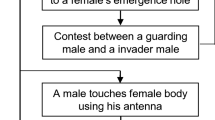Abstract
The reproductive behaviour of a generalist aphidophagous ladybird beetle Cheilomenes sexmaculata (Fabricius) was studied in detail. The males first mated at an age of about 2 days, while females mated at 1 day after their emergence. Mate recognition was displayed in five steps, viz. approach, watch, examine, mount and copulatory attempt. Being provided with four dummy models, the male appeared to recognize the female through visual and other possible cues, maybe chemical. The duration of mating was maximum (mean ± SE; 133.0 ± 2.8 min) when an unmated male copulated with a virgin female and minimum (95.0 ± 4.2 min) when a mated male copulated with a mated female. Mating duration seems to be influenced more by the change in male sexual status, thus revealing it to be male dominated. The maximum oviposition period (46.0 ± 1.2 days), fecundity (861.0 ± 2.2) and hatching percentage (64.0 ± 0.6) in C. sexmaculata were noticed after multiple matings, while these parameters were minimum (15.0 ± 1.0, 70.0 ± 2.8 and 37.0 ± 1.0, respectively) after single mating. Thus, multiple matings enhanced the total egg output and percentage of hatchability.
Similar content being viewed by others
References
Agarwala B. K. and Yasuda H. (2000) Competitive ability of ladybird predators of aphids: A review of Cheilomenes sexmaculata (Fabr.) (Coleoptera: Coccinel-lidae) with a worldwide checklist of preys. Journal of Aphidology 14, 1–20.
Antolin M. E and Strand M. R. (1992) Mating system of Br aeon hebetor (Hymenoptera: Braconidae). Ecological Entomology 17, 1–7.
Dixon A. E G. and Agarwala B. K. (2002) Triangular fecundity function and ageing in ladybird beetles. Ecological Entomology 27, 433–440.
Hemptinne J. L., Dixon A. E. G. and Adam B. (2001) Do males and females of the two-spot ladybird beetle, Adalia bipunctata (L.) differ in when they mature sexually? Journal of Insect Behaviour 14, 411–419.
Hemptinne J. L., Lognay G. and Dixon A. E G. (1998) Mate recognition in the two-spot ladybird beetle, Adalia bipunctata: Role of chemical and behavioural cues. Journal of Insect Physiology 44, 1163–1171.
Hodek I. and Ceryngier P. (2000) Sexual activity in Coccinellidae (Coleoptera): A review. European Journal of Entomology 97, 449–456.
Hodek I. and Honek A. (1996) Ecology of Coccinellidae. Kluwer Academic Publishers, Dordrecht, The Netherlands. 464 pp.
Kaufmann T (1996) Dynamics of sperm transfer, mixing and fertilization in Cryptolaemus montrouzieri (Coleoptera: Coccinellidae) in Kenya. Annals of the Entomological Society of America 89, 238–242.
Majerus M. (1994) Female promiscuity maintains high fertility in ladybird beetles (Col. Coccinellidae). Entomologist’s Monthly Magazine 130, 205–209.
Majerus M. and Kearns P. (1989) Ladybird Beetles. Richmond Publishing Co. Ltd., England. 103 pp.
Mishra G. and Omkar (2006) Conspecific interference by adults in an aphidophagous ladybird: Effect on reproduction. Bulletin of Entomological Research 96, 407–412.
Morjan W. E., Obrycki J. J. and Krasfur E. S. (1991) Inbreeding effects of Propylea auatuordecimpunctata (Coleoptera: Coccinellidae). Annals of the Entomological Society of America 92, 260–268.
Obata S. (1987) Mating behaviour and sperm transfer in the ladybird beetle, Harmonia axyridis (Pallas) (Coleoptera: Coccinellidae). Applied Entomology and Zoology 22, 434–442.
Obata S. (1988) Mating refusal and its significance in females of the ladybird beetle, Harmonia axyridis. Physiological Entomology 13, 193–199.
Obata S. and Hidaka T. (1987) Ejection and ingestion of the spermatophore by the female ladybird beetle, Harmonia axyridis Pallas (Coleoptera: Coccinellidae). Canadian Entomologist 119, 603–604.
Obata S. and Johki Y. (1991) Comparative study on copulatory behaviour in four species of aphidophagous ladybird beetles, pp. 207–212. In Behaviour and Impact of Aphidophaga. Proceedings of the 4th Meeting of the IOBC W.G. Ecology of Aphidophaga, Godollo, Hungary, September 1990 (Edited by L. Polgar). SPB Academic Publishing BV, The Hague, The Netherlands.
Omkar (2004) Reproductive behaviour of two aphidophagous ladybird beetles, Cheilomenes sexmaculata and Coccinella transversalis. Entomologia Sinka 11, 47–60.
Omkar and James B. E. (2005) Reproductive behaviour of an aphidophagous ladybeetle, Coccinella transversalis (Coleoptera: Coccinellidae). International Journal of Tropical Insect Science 25, 96–102.
Omkar and Mishra G. (2005) Mating in aphidophagous ladybirds: Costs and benefits. Journal of Applied Entomology 129, 432–436.
Omkar and Pervez A. (2002) Predaceous coccinellids in India: Predator-prey catalogue. Oriental Insects 38, 27–61.
Omkar and Pervez A. (2005) Mating behaviour of an aphidophagous ladybird beetle, Propylea dissecta (Mulsant). Insect Science (formerly Entomologia Sinka) 12, 37–44.
Omkar and Srivastava S. (2002) The reproductive behaviour of an aphidophagous ladybeetle, Coccinella septempunctata Linnaeus. European Journal of Entomology 99, 465–470.
Omkar, Mishra G. and Singh S. K. (2006) Optimal number of matings in two aphidophagous ladybirds. Ecological Entomology 31, 1–4.
Pervez A., Omkar and Richmond A. S. (2004) The Influence of age on reproductive performance of a predatory ladybird beetle, Propylea dissecta. Journal of Insect Science 4, 1–8.
Srivastava S. and Omkar (2004) Age specific mating and reproductive senescence in seven spotted ladybird, Coccinella septempunctata. Journal of Applied Entomology 128, 452–458.
Srivastava S. and Omkar (2005) Short and long term benefits of promiscuity in a seven-spotted ladybird, Coccinella septempunctata (Coleoptera: Coccinellidae). International Journal of Tropical Insect Science 25, 176–181.
Statistix (1994) Statistix User’ Manual, Version 4.1. Analytical Software. Tallahassee, Florida.
Wang Q., Li J. S., Zeng W. and Yin X. (1991) Sex recognition by males and evidences for female sex pheromone in Paraglenea fortunei (Coleoptera: Cerambycidae). Annals of the Entomological Society of America 84, 85–89.
Wang Q., Zeng W. and Li J. S. (1990) Reproductive behaviour of Paraglenea fortunei (Coleoptera: Cerambycidae). Annals of the Entomological Society of America 83, 860–866.
Author information
Authors and Affiliations
Corresponding author
Rights and permissions
About this article
Cite this article
Bind, R.B. Reproductive behaviour of a generalist aphidophagous ladybird beetle Cheilomenes sexmaculata (Coleoptera: Coccinellidae). Int J Trop Insect Sci 27, 78–84 (2007). https://doi.org/10.1017/S1742758407814688
Accepted:
Published:
Issue Date:
DOI: https://doi.org/10.1017/S1742758407814688




